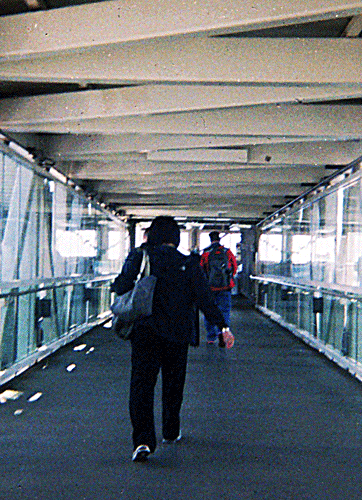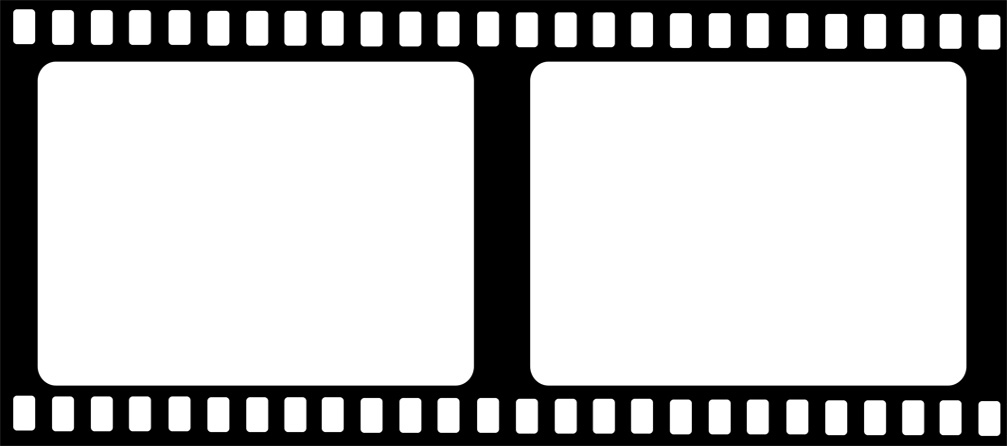Auto-Stereo 3D - Wiggle GIF - Lenticular photo - Piku Piku - Wobble 3D.
This page is dedicated to my journey into the low-tech art form of 35mm lenticular photography combined with GIF animation, also known by one of the names above. These types of photos can no longer be printed that I know of (with maybe one exception). Displaying and viewing these images in a web browser as a wobble GIF is a good option.

While not exactly lenticular photography, but very similar, we should first mention Stereoscopy.
Brief Explanation of Stereoscopy
Originally, stereoscopic images were called stereograms and were used to display 3d images. Invented in the 1800s, you could use a stereoscopic viewer to see 3D paired images such as the one below. Without the viewer, you can still see this 3D effect if you cross your eyes in just the right way so you see 3 images. Focus on the image in the middle and you should begin to see depth in the image. A popular stereoscopic viewer you may have been familiar with as a child is the View-Master. A more accurate and concise write-up on the history of stereoscopy and stereoscopic images than I could ever hope to create, can be viewed here at Wikipedia. I should also mention that there is a very cool tool at the New York Public Library website called the Stereogranimator. The Stereogranimator will let you search for these stereograms and convert them to wiggle gifs for you on the fly. It is really nice to see these old images getting a new lease on life.

The nuts and bolts of wobble 3D GIFs and quality issues
Question: Why is the quality so low with these wobble GIFs?
A few reasons. To begin with, the camera I have uses two 35mm frames per each image. In other words, you get 12 images from a 24 exposure roll. So right off the bat we have half of a typical 35mm frame to work with.


The second reason for the low quality is that the available cameras that can make 3D pictures (with 4 frames) all hail from a different era, specifically the 1980s and early 1990s. The camera I currently have is a Nishika n9000 and I purchased it on ebay for $11. A knock off of the earlier and better built Nimslo camera, the Nishika is almost disposable. The 4 lenses on it are plastic and there are very few options that come with the camera. One nice feature it has is a hot shoe mount for a flash unit, but a flash is pretty much a mandatory option for taking pictures indoors. A very good discussion on the Nishika company and its cameras can be read about here. Reading through the Nishika documentation is like being in an episode of the Twilight Zone. The camera is new enough to look almost modern (1991) yet there is no mention of visiting websites or email. The camera even came with mailers for sending film in for 3D processing. After living in the digital photography realm for the last few years, seeing all this "old fashioned technology" is like a blast from the past
A third reason for the low-fi look is the scanner I used to scan the film. I am currently using a cheap dedicated film and slide scanner I purchased from Costco a few years ago for about $45. It has sat on my shelf for a long time and was just covered with dust. That's why there is so many dusty looking artifacts on the images, it's dust. I've recently torn the scanner apart in an attempt to clean it. Its better now but it still leaves some dust on the images. The reviews for this scanner reveal that it is one of the lower end models.

Finally we come to the last reason for the low quality in the images. The small image sizes needed for use on the internet require that we animate the separate frames using the GIF format. Created by Compuserve in 1987, yes I said 1987, the GIF, or Graphics Interchange Format is probably the best choice for displaying wobble 3D graphics. Other formats exist such as Flash or animated PNG images, but they are not as widely supported by web browsers. The GIF format is ideal because the file size remains relatively small considering all the animation it outputs. Limited to only 256 colors however, good results can be difficult to come by without proper software, e.g., Photoshop.

3D Photography Links
I learned a lot from this site - Lenticulations.
See his 'about' page for good advice
on how to make your own wobble gifs.
Different types of Lenticular and
Stereo Cameras with descriptions.
These guys are bringing sexy, back
to the GIF format - GIFRIENDS.
An online Nimslo Camera Manual.
NY Public Library Stereogranimator
(very cool!)
Excellent How-to video from Mr GIF
over at the Creators Project. This is
essentially the same way I make my GIFs.
If you are looking for a more modern solution for 3D stereoscopic photography, Fuji has made a digital 2 lens 3D camera called the FinePix REAL 3D W3. The images from the Fuji model seem to be pretty good, but the lack of 4 lenses has left me opting for the Nishika for now. I am currently waiting for a good deal on a Nimslo to appear on Ebay.
1980s Nimslo Commercial
Its a Miracle!

